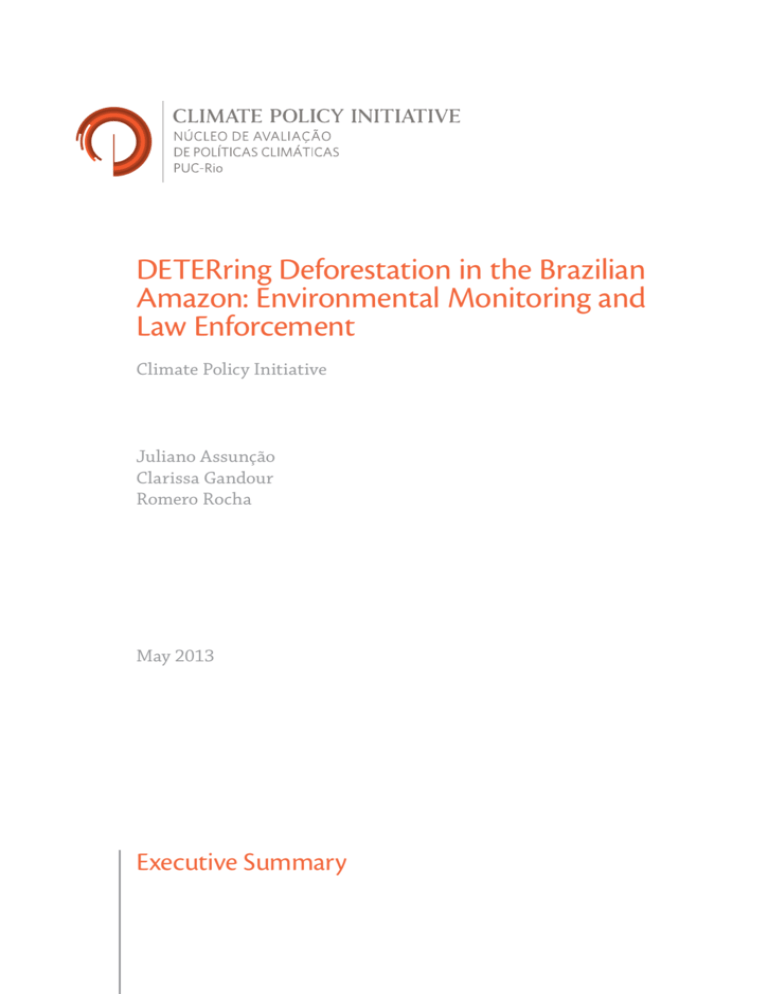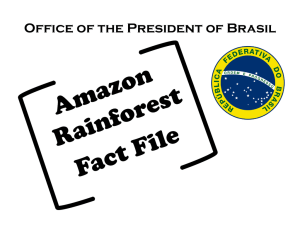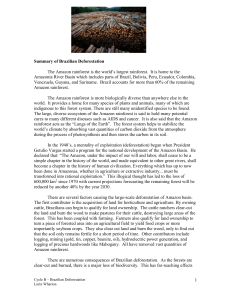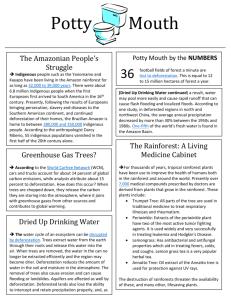
DETERring Deforestation in the Brazilian
Amazon: Environmental Monitoring and
Law Enforcement
Climate Policy Initiative
Juliano Assunção
Clarissa Gandour
Romero Rocha
May 2013
Executive Summary
Descriptors
Sector
Region
Keywords
Contact
Land Use, Forestry
Brazil, Amazon
deforestation, conservation policies, law enforcement, command and control
Juliano Assunção
juliano@cpirio.org
About the Executive Summary
This document presents the main findings of “DETERring Deforestation in the Brazilian Amazon:
Environmental Monitoring and Law Enforcement” by Assunção et al. (2013). Please refer to the paper
for a comprehensive discussion of the study.
Acknowledgements
Juliana Portella and Karla Gregório provided excellent research assistance. We thank the Brazilian
Ministry of the Environment, and particularly Francisco Oliveira, for their continuous support. We
are also grateful to Andrew Hobbs, Angela Falconer, Arthur Bragança, David Nelson, Dimitri Szerman,
Elysha Rom-Povolo, Jane Wilkinson, Joana Chiavari, and Pedro Hemsley for helpful comments.
About CPI
Climate Policy Initiative is a global policy effectiveness analysis and advisory organization. Its mission is
to assess, diagnose, and support nations’ efforts to achieve low-carbon growth. An independent, notfor-profit organization supported by a grant from the Open Society Foundations, CPI’s headquarters
are in the U.S., with offices and programs in Brazil, China, Europe, India, and Indonesia.
Copyright © 2013 Climate Policy Initiative www.climatepolicyinitiative.org
All rights reserved. CPI welcomes the use of its material for noncommercial purposes, such as policy discussions or educational activities, under a Creative Commons Attribution-NonCommercial-ShareAlike 3.0
Unported License. For commercial use, please contact admin@cpisf.org.
DETERring Deforestation in the Brazilian Amazon
May 2013
Executive Summary
The Amazon is the world’s largest rainforest. In Brazil,
the forest originally occupied over four million km2 – an
area equivalent to almost half of continental Europe.
Around 80% of the Brazilian Amazon remains covered
by native vegetation, making it an important carbon
sink. Moreover, the Brazilian Amazon holds unique
biodiversity and 20% of the planet’s fresh water (MMA
[2012]). Amazon deforestation rates escalated in the
early 2000s, peaking at over 27,000 km2 in 2004, but
fell sharply to about 5,000 km2 in 2011 (INPE [2012]).
Empirical evidence presented in previous CPI/PUC-Rio
studies suggest that changes in Brazilian conservation
policies helped address the challenge of protecting
this immense area and significantly contributed to the
recent deforestation slowdown.
In this study, we take a step further and answer the
question: Which specific policy efforts contributed
most to the reduction in Amazon deforestation? Our
analysis reveals that the implementation of the Real
Time System for Detection of Deforestation (DETER), a
satellite-based system that enables frequent and quick
identification of deforestation hot spots, was the main
driver of the 2000s deforestation slowdown. Since its
activation, DETER has served as the basis for targeting
monitoring and law enforcement activity in the Amazon.
We estimate that DETER-based environmental monitoring and law enforcement policies prevented the
clearing of over 59,500 km2 of Amazon forest area
from 2007 through 2011. Deforestation observed
during this period totaled 41,500 km2 – 59% less
than in the absence of the policy change. We also find
that the policy change had no impact on agricultural
production.
Improving Monitoring and Law
Enforcement in the Amazon
The Action Plan for the Prevention and Control of
Deforestation in the Legal Amazon (PPCDAm) was the
pivotal conservation policy effort of the 2000s. One
of the main changes it introduced was a major leap
forward in remote sensing-based Amazon monitoring capacity brought about by the implementation of
DETER. Developed by the National Institute for Space
Research (INPE), DETER is a satellite-based system
that captures and processes georeferenced imagery on
forest cover in 15-day intervals.
Figure 2 shows how deforestation is captured by DETER.
The system, capable of detecting deforested areas
larger than 25 hectares, portrays deforested areas in
purple and forest areas in green. For any given location,
recent images are compared with older ones to identify
changes in forest cover. This procedure is used to locate
deforestation hot spots and issue alerts signaling areas
in need of immediate attention. The Brazilian Institute
for the Environment and Renewable Natural Resources
(Ibama), which operates as the national environmental police and law enforcement authority, targets law
enforcement activities in the Amazon based on these
alerts.
Figure 1: Deforestation in the Amazon Biome
DEFORESTATION (THOUSAND KM2)
25
ESTIMATED IN THE ABSENCE
OF THE POLICY CHANGE
20
15
10
OBSERVED
5
2007
A CPI Report
2008
2009
2010
2011
I
May 2013
Prior to the activation of DETER, Amazon monitoring
depended on voluntary and anonymous reports of
threatened areas, making it difficult for Ibama to identify
and access deforestation hot spots in a timely manner.
With the adoption of the new remote sensing system,
Ibama was able to better identify, more closely monitor,
and more quickly act upon areas with illegal deforestation activity.
DETERring Deforestation in the Brazilian Amazon
Figure 2: DETER Satellite Imagery
The PPCDAm also promoted institutional changes that
enhanced command and control capabilities in the
Amazon. These changes increased the number and
qualification of law enforcement personnel, and brought
greater regulatory stability to the investigation of environmental crimes and application of sanctions. In particular, they regulated the use of legal instruments for
the punishment of environmental crimes. These instruments included, but were not limited to, fines, embargoes, seizure of production goods, tools and material,
and arrest. The policy changes also established the
legal basis for singling out municipalities with very high
deforestation rates – known as priority municipalities –
and taking differentiated action towards them.
A Word on Methodology
Estimating the impact of monitoring and law enforcement on illegal deforestation is a challenging
task. Because the allocation of law enforcement teams typically targets areas under greater risk of
deforestation, the correlation between the presence of the enforcers and forest clearings is jointly
determined by the risk-based targeting strategy and the deterrent effect of monitoring and law
enforcement. Estimation of the causal effect of monitoring and law enforcement on deforestation
therefore hinges on successfully disentangling the impact of the two determinants. To do this within
the context of the Brazilian Amazon, we must identify a source of variation in the allocation of Ibama
resources that is not associated with deforestation.
Bearing this in mind, we exploit a key characteristic of the DETER system in our empirical strategy.
DETER is incapable of detecting land cover patterns in areas covered by clouds, so no deforestation
activity is captured and no deforestation alerts are issued in these areas. Ultimately, this reduces the
probability of monitoring personnel being allocated to such areas. It is therefore likely that monitoring
and law enforcement in the Amazon are directly affected by DETER cloud coverage.
We derive an empirical strategy that uses average annual DETER cloud coverage for a municipality as a
source of variation in the allocation of Ibama resources that is not driven by deforestation activity. Our
analysis is based on a two-step procedure. First, we show that DETER cloud coverage systematically
affects Ibama presence, as measured by the annual number of environmental fines applied at the
municipality level. A greater number of fines is regarded as indicative of more stringent monitoring and
law enforcement. Second, we quantify the deterrent impact of the presence of Ibama on deforestation.
In a nutshell, we show that Ibama is systematically less present in municipalities with greater cloud
cover in any given year, and that these municipalities exhibit higher deforestation the following year.
A CPI Report
II
DETERring Deforestation in the Brazilian Amazon
May 2013
Table 1: Observed and Estimated Deforestation in the Amazon Biome (km2)
HYPOTHETICAL SCENARIO 1
(NUMBER OF FINES FROM 2007 THROUGH 2011
EQUAL TO NUMBER OF FINES RECORDED IN 2003)
HYPOTHETICAL SCENARIO 2
(NUMBER OF FINES FROM 2007 THROUGH 2011
EQUAL TO ZERO)
YEAR
OBSERVED
DEFORESTATION
ESTIMATED
DEFORESTATION
DIFFERENCE:
ESTIMATED - OBSERVED
ESTIMATED
DEFORESTATION
DIFFERENCE:
ESTIMATED - OBSERVED
2007
11,263
20,289
9,026
32,933
21,669
2008
12,918
23,432
10,514
36,075
23,157
2009
5,663
20,960
15,297
33,603
27,940
2010
6,109
20,498
14,389
33,141
27,033
2011
5,610
15,895
10,285
28,538
22,928
Total
2007-2011
41,563
101,073
59,511
164,290
122,727
The Effect on Deforestation
Our results indicate that the presence of Ibama, captured by the number of environmental fines applied in a
municipality in a given year, significantly reduces deforestation the following year. This suggests that effective
monitoring and law enforcement can curb deforestation.
To better understand the magnitude of this effect, we
conduct two simulations to estimate total deforestation
in hypothetical scenarios that differ from the observed
reality. In the first scenario, we assume that the annual
number of fines in each municipality from 2007 through
2011 was equal to that observed in 2003, the year
immediately preceding the launch of the PPCDAm.
In doing so, we recreate a scenario in which monitoring and law enforcement policy stringency remained
unchanged after the implementation of the PPCDAm.
We then estimate the deforestation trend for this
hypothetical scenario. Table 1 presents both observed
and estimated annual deforestation. Our analysis
shows that, had command and control policy remained
unchanged, the Amazon Biome would have seen over
101,000 km2 of deforestation from 2007 through 2011.
Compared to the 41,500 km2 of deforestation actually
observed during this period, results suggest that the
more stringent monitoring and law enforcement policies
preserved over 59,500 km2 of forest area.
In the second simulation, we assume that no fines were
applied in all Amazon Biome municipalities from 2007
through 2011. This scenario captures the complete
absence of monitoring and law enforcement in the
Amazon. Table 1 again presents both observed and estimated deforestation. We calculate that, without monitoring and law enforcement activities, over 164,200 km2
of forest would have been cleared in the 2007 through
2011 period. Compared to observed deforestation,
A CPI Report
results indicate that such activities preserved more than
122,700 km2 of forest area.
Costs and Benefits of Monitoring and Law
Enforcement: Worth It?
We now show a simple calculation of the costs and benefits of monitoring and law enforcement in the Brazilian
Amazon. In this simplified cost-benefit analysis, we
compare the sum of Ibama’s and INPE’s annual budgets
with the estimated monetary benefits of preserving
forest areas and thereby avoiding carbon dioxide emissions. In this exercise, we use the avoided deforestation
results from our second simulation to account for the
deterrent effect of monitoring and law enforcement as a
whole, and not only that of the policy change.
Ibama’s 2011 budget was USD 560 million, while INPE’s
2010 budget was USD 125 million. According to our
simulation, command and control efforts preserved an
average of 24,500 km2 of forest area per year in the
2007 through 2011 period. This area is equivalent to
approximately 900 million tCO2.1 Therefore, any price
of carbon set above 0.76 USD/tCO2 would more than
compensate the cost of environmental monitoring and
law enforcement in the Amazon. Compared to the price
of 5.00 USD/tCO2 commonly used in current applications, these figures suggest that the presence of an
active monitoring and law enforcement authority in the
Amazon has the potential to yield significant net monetary gains. Indeed, our estimates capture the lower
bound of this potential gain. Considering that, in reality,
only a share of Ibama’s and INPE’s budgets is used for
Amazon monitoring and law enforcement, our cost-benefit comparison becomes even more striking.
1
Estimations are based on a conversion factor of 10,000 tC/km2 (36,700
tCO2/km2), as established in MMA/DPCD (2011).
III
May 2013
The Effect on Agricultural Production
There is an ongoing debate about how conservation policies and economic growth interact. While some worry
that the preservation of natural resources can only be
achieved at the expense of economic growth, many
posit that society can – and should – jointly pursue the
two goals. In particular, some argue that agricultural
producers could increase output by boosting productivity, instead of expanding production into new – often
forested – areas. This productivity growth could more
than compensate potential costs of conservation efforts.
We address this debate by investigating whether the
change in monitoring and law enforcement policies had
an impact on local agricultural production. We find that
the number of fines applied by Ibama in a given municipality had no effect on agricultural production.
Our results show that DETER-based monitoring and law
enforcement played a crucial role in curbing Amazon
deforestation, and thereby containing carbon dioxide
emissions, without adversely affecting agricultural production. This suggests that it is possible to protect the
native forest without significantly interfering with local
agricultural production.
Policy Implications
Our analysis shows that the adoption of a satellite-based system for real-time monitoring of deforestation and better targeting of law enforcement activities
effectively reduced deforestation in the Brazilian
Amazon. This yields two main policy implications.
1. Maintain monitoring and law enforcement
activities in the Brazilian Amazon. In addition to
showing that more stringent monitoring and law
enforcement policies reduced deforestation, our
results highlight the quantitative relevance of these
policies’ deterrent effect. We find that the total
amount of avoided deforestation attributed to the
policies in a five-year period is almost as large as
the impact of a whole set of conservation policies
introduced in the second half of the 2000s (see
Assunção et al. [2012]). Although in this study
we estimate avoided deforestation in a slightly
different five-year window from the one used in the
previous CPI/PUC-Rio study, the sheer magnitude
of the forest area that was preserved indicates that
the relative impact of DETER-based monitoring
and law enforcement was far greater than that of
other conservation policies implemented under
the PPCDAm framework. This does not in any way
imply that other policies should not be used to
A CPI Report
DETERring Deforestation in the Brazilian Amazon
combat deforestation. Rather, it suggests that such
policies are complementary to monitoring and law
enforcement efforts, effectively deterring forest
clearings at the margin, while monitoring and law
enforcement contain the bulk of deforestation.
Additionally, our findings show that the policy
change had no effect on agricultural production.
This finding reinforces the case for relying on
monitoring and law enforcement to protect
the Amazon. Moreover, it indicates that, in the
Amazon region, both preservation and economic
growth can happen simultaneously, contrary to
any perceived dichotomy between these two
goals.
2. Improve monitoring technology. Our results also
suggest that better monitoring technology could
further increase the effectiveness of Amazon
law enforcement activities. Overcoming DETER’s
incapacity to see through clouds and obtaining
land cover imagery in higher resolutions are two
examples of technological advances that could
enhance law enforcement targeting capability and
add significant value to Brazil’s conservation efforts.
Bibliography (executive summary only)
Assunção, J., Gandour, C., and Rocha, R. (2012). Deforestation Slowdown in the Legal Amazon: Prices or
Policies? CPI Rio Working Paper 1.
Ministério do Meio Ambiente, Departamento de Políticas para o Combate ao Desmatamento - MMA/
DPCD (2011). Nota Técnica N° 22.
Ministério do Meio Ambiente - MMA (2012). Brazilian
Policy to Tackle Deforestation in the Amazon. In
Rio+20 United Nations Conference on Sustainable
Development.
IV







